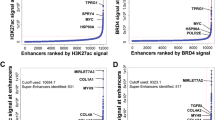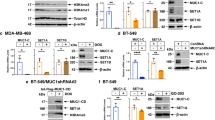Abstract
The MUC1 cytoplasmic tail (MUC1.CT) conducts signals from spatial and extracellular cues (growth factor and cytokine stimulation) to evoke a reprogramming of the cellular transcriptional profile. Specific phosphorylated forms of the MUC1.CT achieve this function by differentially associating with transcription factors and redirecting their transcriptional regulatory capabilities at specific gene regulatory elements. The specificity of interaction between MUC1.CT and several transcription factors is dictated by the phosphorylation pattern of the 18 potential phosphorylation motifs within the MUC1.CT. To better appreciate the scope of differential gene expression triggered by MUC1.CT activation, we performed microarray gene expression analysis and chromatin immunoprecipitation (ChIP)–chip promoter analysis and identified the genome-wide transcriptional targets of MUC1.CT signaling in pancreatic cancer. On a global scale, MUC1.CT preferentially targets genes related to invasion, angiogenesis and metastasis, suggesting that MUC1.CT signaling contributes to establishing a reactive tumor microenvironment during tumor progression to metastatic disease. We examined in detail the molecular mechanisms of MUC1.CT signaling that induces the expression of connective tissue growth factor (CTGF/CCN2), a potent mediator of ECM remodeling and angiogenesis. We demonstrate a robust induction of CTGF synthesis and secretion in response to serum factors that is enabled only when MUC1 is highly expressed. We demonstrate the requirement of phosphorylation at distinct tyrosine motifs within the MUC1.CT for MUC1-induced CTGF expression and demonstrate a phosphorylation-specific localization of MUC1.CT to the CTGF promoter. We found that MUC1 reorganizes transcription factor occupancy of genomic regions upstream of the CTGF gene, directing β-catenin and mutant p53 to CTGF gene regulatory elements to promote CTGF expression and destabilizing the interaction at these regions of the transcriptional repressor, c-Jun. With this example we illustrate the capacity of MUC1.CT to mediate transcription factor activity in a context-dependent manner to achieve wide spread and robust changes in gene expression and facilitate creation of the reactive tumor microenvironment.
This is a preview of subscription content, access via your institution
Access options
Subscribe to this journal
Receive 50 print issues and online access
$259.00 per year
only $5.18 per issue
Buy this article
- Purchase on Springer Link
- Instant access to full article PDF
Prices may be subject to local taxes which are calculated during checkout





Similar content being viewed by others
References
Agata N, Ahmad R, Kawano T, Raina D, Kharbanda S, Kufe D . (2008). MUC1 oncoprotein blocks death receptor-mediated apoptosis by inhibiting recruitment of caspase-8. Cancer Res 68: 6136–6144.
Aikawa T, Gunn J, Spong SM, Klaus SJ, Korc M . (2006). Connective tissue growth factor-specific antibody attenuates tumor growth, metastasis, and angiogenesis in an orthotopic mouse model of pancreatic cancer. Mol Cancer Ther 5: 1108–1116.
Bennewith KL, Huang X, Ham CM, Graves EE, Erler JT, Kambham N et al. (2009). The role of tumor cell-derived connective tissue growth factor (CTGF/CCN2) in pancreatic tumor growth. Cancer Res 69: 775–784.
Brigstock DR . (2003). The CCN family: a new stimulus package. J Endocrinol 178: 169–175.
Burdick MD, Harris A, Reid CJ, Iwamura T, Hollingsworth MA . (1997). Oligosaccharides expressed on MUC1 produced by pancreatic and colon tumor cell lines. J Biol Chem 272: 24198–24202.
Carson DD . (2008). The cytoplasmic tail of MUC1: a very busy place. Sci Signal 1: pe35.
Chu CY, Chang CC, Prakash E, Kuo ML . (2008). Connective tissue growth factor (CTGF) and cancer progression. J Biomed Sci 15: 675–685.
Deng YZ, Chen PP, Wang Y, Yin D, Koeffler HP, Li B et al. (2007). Connective tissue growth factor is overexpressed in esophageal squamous cell carcinoma and promotes tumorigenicity through beta-catenin-T-cell factor/Lef signaling. J Biol Chem 282: 36571–36581.
Gao J, McConnell MJ, Yu B, Li J, Balko JM, Black EP et al. (2009). MUC1 is a downstream target of STAT3 and regulates lung cancer cell survival and invasion. Int J Oncol 35: 337–345.
Gatto M, Drudi-Metalli V, Torrice A, Alpini G, Cantafora A, Blotta I et al. (2008). Insulin-like growth factor-1 isoforms in rat hepatocytes and cholangiocytes and their involvement in protection against cholestatic injury. Lab Invest 88: 986–994.
Hollingsworth MA, Swanson BJ . (2004). Mucins in cancer: protection and control of the cell surface. Nat Rev Cancer 4: 45–60.
Husson H, Carideo EG, Neuberg D, Schultze J, Munoz O, Marks PW et al. (2002). Gene expression profiling of follicular lymphoma and normal germinal center B cells using cDNA arrays. Blood 99: 282–289.
Iwamura T, Taniguchi S, Kitamura N, Yamanari H, Kojima A, Hidaka K et al. (1992). Correlation between CA19–9 production in vitro and histological grades of differentiation in vivo in clones isolated from a human pancreatic cancer cell line (SUIT-2). J Gastroenterol Hepatol 7: 512–519.
Kohlgraf KG, Gawron AJ, Higashi M, Meza JL, Burdick MD, Kitajima S et al. (2003). Contribution of the MUC1 tandem repeat and cytoplasmic tail to invasive and metastatic properties of a pancreatic cancer cell line. Cancer Res 63: 5011–5020.
Leask A, Holmes A, Black CM, Abraham DJ . (2003). Connective tissue growth factor gene regulation. requirements for its induction by transforming growth factor-beta 2 in fibroblasts. J Biol Chem 278: 13008–13015.
Li Y, Bharti A, Chen D, Gong J, Kufe D . (1998). Interaction of glycogen synthase kinase 3beta with the DF3/MUC1 carcinoma-associated antigen and beta-catenin. Mol Cell Biol 18: 7216–7224.
Li Y, Kuwahara H, Ren J, Wen G, Kufe D . (2001a). The c-src tyrosine kinase regulates signaling of the human DF3/MUC1 carcinoma-associated antigen with GSK3 beta and beta-catenin. J Biol Chem 276: 6061–6064.
Li Y, Ren J, Yu W, Li Q, Kuwahara H, Yin L et al. (2001b). The epidermal growth factor receptor regulates interaction of the human DF3/MUC1 carcinoma antigen with c-src and beta-catenin. J Biol Chem 276: 35239–35242.
Masaki Y, Oka M, Ogura Y, Ueno T, Nishihara K, Tangoku A et al. (1999). Sialylated MUC1 mucin expression in normal pancreas, benign pancreatic lesions, and pancreatic ductal adenocarcinoma. Hepatogastroenterology 46: 2240–2245.
Masuko K, Murata M, Yudoh K, Shimizu H, Beppu M, Nakamura H et al. (2010). Prostaglandin E2 regulates the expression of connective tissue growth factor (CTGF/CCN2) in human osteoarthritic chondrocytes via the EP4 receptor. BMC Res Notes 3: 5.
McDermott KM, Crocker PR, Harris A, Burdick MD, Hinoda Y, Hayashi T et al. (2001). Overexpression of MUC1 reconfigures the binding properties of tumor cells. Int J Cancer 94: 783–791.
Pemberton LF, Rughetti A, Taylor-Papadimitriou J, Gendler SJ . (1996). The epithelial mucin MUC1 contains at least two discrete signals specifying membrane localization in cells. J Biol Chem 271: 2332–2340.
Qu CF, Li Y, Song YJ, Rizvi SM, Raja C, Zhang D et al. (2004). MUC1 expression in primary and metastatic pancreatic cancer cells for in vitro treatment by (213)bi-C595 radioimmunoconjugate. Br J Cancer 91: 2086–2093.
Raina D, Ahmad R, Chen D, Kumar S, Kharbanda S, Kufe D . (2008). MUC1 oncoprotein suppresses activation of the ARF-MDM2-p53 pathway. Cancer Biol Ther 7: 1959–1967.
Shimo T, Nakanishi T, Nishida T, Asano M, Kanyama M, Kuboki T et al. (1999). Connective tissue growth factor induces the proliferation, migration, and tube formation of vascular endothelial cells in vitro, and angiogenesis in vivo. J Biochem 126: 137–145.
Singh PK, Behrens ME, Eggers JP, Cerny RL, Bailey JM, Shanmugam K et al. (2008). Phosphorylation of MUC1 by met modulates interaction with p53 and MMP1 expression. J Biol Chem 283: 26985–26995.
Singh PK, Hollingsworth MA . (2006). Cell surface-associated mucins in signal transduction. Trends Cell Biol 16: 467–476.
Singh PK, Wen Y, Swanson BJ, Shanmugam K, Kazlauskas A, Cerny RL et al. (2007). Platelet-derived growth factor receptor beta-mediated phosphorylation of MUC1 enhances invasiveness in pancreatic adenocarcinoma cells. Cancer Res 67: 5201–5210.
Sun Y, Zeng XR, Wenger L, Firestein GS, Cheung HS . (2004). P53 down-regulates matrix metalloproteinase-1 by targeting the communications between AP-1 and the basal transcription complex. J Cell Biochem 92: 258–269.
Takagi J, DeBottis DP, Erickson HP, Springer TA . (2002). The role of the specificity-determining loop of the integrin beta subunit I-like domain in autonomous expression, association with the alpha subunit, and ligand binding. Biochemistry 41: 4339–4347.
Tsutsumida H, Swanson BJ, Singh PK, Caffrey TC, Kitajima S, Goto M et al. (2006). RNA interference suppression of MUC1 reduces the growth rate and metastatic phenotype of human pancreatic cancer cells. Clin Cancer Res 12: 2976–2987.
Wei X, Xu H, Kufe D . (2007). Human mucin 1 oncoprotein represses transcription of the p53 tumor suppressor gene. Cancer Res 67: 1853–1858.
Wei X, Xu H, Kufe D . (2005). Human MUC1 oncoprotein regulates p53-responsive gene transcription in the genotoxic stress response. Cancer Cell 7: 167–178.
Wen Y, Caffrey TC, Wheelock MJ, Johnson KR, Hollingsworth MA . (2003). Nuclear association of the cytoplasmic tail of MUC1 and beta-catenin. J Biol Chem 278: 38029–38039.
Wenger C, Ellenrieder V, Alber B, Lacher U, Menke A, Hameister H et al. (1999). Expression and differential regulation of connective tissue growth factor in pancreatic cancer cells. Oncogene 18: 1073–1080.
Yang DH, Kim HS, Wilson EM, Rosenfeld RG, Oh Y . (1998). Identification of glycosylated 38-kDa connective tissue growth factor (IGFBP-related protein 2) and proteolytic fragments in human biological fluids, and up-regulation of IGFBP-rP2 expression by TGF-beta in Hs578T human breast cancer cells. J Clin Endocrinol Metab 83: 2593–2596.
Yi CH, Smith DJ, West WW, Hollingsworth MA . (2007). Loss of fibulin-2 expression is associated with breast cancer progression. Am J Pathol 170: 1535–1545.
Yuan Z, Liu X, Wong S, Machan JT, Chung MA . (2008). MUC1 knockdown with RNA interference inhibits pancreatic cancer growth. J Surg Res 157: e39–e46.
Zarrinkalam KH, Stanley JM, Gray J, Oliver N, Faull RJ . (2003). Connective tissue growth factor and its regulation in the peritoneal cavity of peritoneal dialysis patients. Kidney Int 64: 331–338.
Author information
Authors and Affiliations
Corresponding author
Ethics declarations
Competing interests
The authors declare no conflict of interest.
Additional information
Supplementary Information accompanies the paper on the Oncogene website
Supplementary information
Rights and permissions
About this article
Cite this article
Behrens, M., Grandgenett, P., Bailey, J. et al. The reactive tumor microenvironment: MUC1 signaling directly reprograms transcription of CTGF. Oncogene 29, 5667–5677 (2010). https://doi.org/10.1038/onc.2010.327
Received:
Revised:
Accepted:
Published:
Issue Date:
DOI: https://doi.org/10.1038/onc.2010.327
Keywords
This article is cited by
-
An intrinsic purine metabolite AICAR blocks lung tumour growth by targeting oncoprotein mucin 1
British Journal of Cancer (2023)
-
The multifaceted role of MUC1 in tumor therapy resistance
Clinical and Experimental Medicine (2022)
-
Crosstalk between MUC1 and VEGF in angiogenesis and metastasis: a review highlighting roles of the MUC1 with an emphasis on metastatic and angiogenic signaling
Cancer Cell International (2021)
-
Spatial transcriptomics at subspot resolution with BayesSpace
Nature Biotechnology (2021)
-
MUC1 oncoprotein mitigates ER stress via CDA-mediated reprogramming of pyrimidine metabolism
Oncogene (2020)



